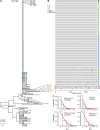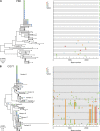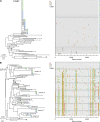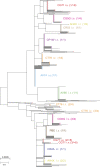Low-dose rectal inoculation of rhesus macaques by SIVsmE660 or SIVmac251 recapitulates human mucosal infection by HIV-1
- PMID: 19414559
- PMCID: PMC2715022
- DOI: 10.1084/jem.20082831
Low-dose rectal inoculation of rhesus macaques by SIVsmE660 or SIVmac251 recapitulates human mucosal infection by HIV-1
Abstract
We recently developed a novel strategy to identify transmitted HIV-1 genomes in acutely infected humans using single-genome amplification and a model of random virus evolution. Here, we used this approach to determine the molecular features of simian immunodeficiency virus (SIV) transmission in 18 experimentally infected Indian rhesus macaques. Animals were inoculated intrarectally (i.r.) or intravenously (i.v.) with stocks of SIVmac251 or SIVsmE660 that exhibited sequence diversity typical of early-chronic HIV-1 infection. 987 full-length SIV env sequences (median of 48 per animal) were determined from plasma virion RNA 1-5 wk after infection. i.r. inoculation was followed by productive infection by one or a few viruses (median 1; range 1-5) that diversified randomly with near starlike phylogeny and a Poisson distribution of mutations. Consensus viral sequences from ramp-up and peak viremia were identical to viruses found in the inocula or differed from them by only one or a few nucleotides, providing direct evidence that early plasma viral sequences coalesce to transmitted/founder viruses. i.v. infection was >2,000-fold more efficient than i.r. infection, and viruses transmitted by either route represented the full genetic spectra of the inocula. These findings identify key similarities in mucosal transmission and early diversification between SIV and HIV-1, and thus validate the SIV-macaque mucosal infection model for HIV-1 vaccine and microbicide research.
Figures







References
-
- Haase A.T. 2005. Perils at mucosal front lines for HIV and SIV and their hosts.Nat. Rev. Immunol. 5:783–792 - PubMed
-
- Pope M., Haase A.T. 2003. Transmission, acute HIV-1 infection and the quest for strategies to prevent infection.Nat. Med. 9:847–852 - PubMed
-
- Shattock R.J., Moore J.P. 2003. Inhibiting sexual transmission of HIV-1 infection.Nat. Rev. Microbiol. 1:25–34 - PubMed
-
- Keele B.F., Giorgi E.E., Salazar-Gonzalez J.F., Decker J.M., Pham K.T., Salazar M.G., Sun C., Grayson T., Wang S., Li H., et al. 2008. Identification and characterization of transmitted and early founder virus envelopes in primary HIV-1 infection.Proc. Natl. Acad. Sci. USA. 105:7552–7557 - PMC - PubMed
Publication types
MeSH terms
Substances
Grants and funding
LinkOut - more resources
Full Text Sources
Other Literature Sources
Medical

